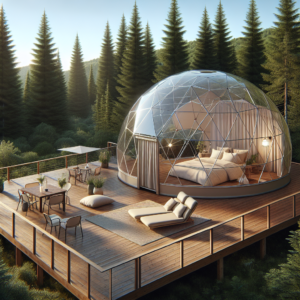
Key Takeaways
-
Discover innovative solutions to dome condensation issues.
-
Learn about the latest technological advancements in garden dome design.
-
Understand the science behind preventing condensation in garden domes.
-
Explore practical steps for installing and maintaining a clear garden dome.
As garden enthusiasts, we all strive for that perfect oasis where we can relax and watch nature thrive in our own backyards. One of the latest trends in garden design is the use of crystal clear garden domes. These domes not only offer a unique aesthetic but also provide a controlled environment for plants to flourish. However, maintaining that crystal clear appearance can be a challenge due to condensation. Let’s dive into how we can manage this effectively.
Clearing the Fog: A New Dawn in Dome Condensation Management
Imagine waking up to a serene view of your garden, encapsulated in a dome that offers a 360-degree vista of your blooming flowers and lush greenery. Now, imagine that view obscured by the foggy veil of condensation. It’s not just a matter of visibility; condensation can lead to mold, mildew, and a host of other issues that threaten the health of your plants. The good news is, with the right techniques, you can keep your dome as clear as the day it was installed.
Firstly, let’s tackle the root of the problem: excess moisture. By carefully controlling the humidity inside your dome, you can prevent condensation from forming. This means being meticulous with watering schedules, ensuring proper soil drainage, and perhaps incorporating a dehumidifier if necessary. Remember, the goal is to create an environment where plants thrive without compromising the clarity of your dome.
Next, consider the material of your dome. Advances in materials technology have brought us super-hydrophobic coatings and materials that repel water, reducing the likelihood of condensation. When choosing your garden dome, look for these modern materials that offer built-in condensation resistance. It’s a simple choice that can save you a lot of hassle in the long run.
Latest Technological Advancements in Dome Engineering
The world of garden domes is evolving rapidly, with new materials and designs emerging to tackle the age-old problem of condensation. These advancements are not just about keeping your view clear; they’re about creating a sustainable, long-lasting environment for your plants. From UV-resistant plastics to self-cleaning glass, the options are becoming more sophisticated and more effective.
One of the most exciting developments is the integration of smart technology into dome design. Imagine a dome that can automatically adjust its ventilation based on humidity levels, or one that can change its opacity to protect your plants from harsh sunlight. These smart domes are not just a concept; they’re a reality that’s making garden management easier and more efficient than ever before.
Comparative Analysis: Traditional Vs. Modern Techniques
It’s important to understand how far we’ve come in the world of garden dome technology. Traditional domes often relied on constant manual intervention to manage condensation. Gardeners would have to wipe down the interior, use fans for circulation, or even apply anti-fog treatments regularly.
In contrast, modern domes are designed with condensation management in mind. They incorporate features like built-in ventilation systems, materials that minimize moisture retention, and even coatings that prevent water droplets from sticking to the surface. This means less time spent on maintenance and more time enjoying your garden.
But don’t just take my word for it. Let’s look at some real-world examples. In a recent case, a gardener in Seattle replaced her old polycarbonate dome with a new model featuring a hydrophobic coating. The difference was night and day. Where she once had to clear fog every morning, now she enjoys uninterrupted views regardless of the weather.
Condensation Management: The Science Explained

Understanding the science behind condensation will help you make informed decisions about managing it. Condensation occurs when warm, moist air comes into contact with a cooler surface, causing the moisture in the air to turn into liquid on that surface. In a garden dome, this can happen overnight when temperatures drop or when there’s a sudden change in weather.
Effective condensation management in garden domes is all about controlling these environmental factors. This means regulating the temperature inside the dome, ensuring adequate air circulation, and selecting the right materials for your dome’s construction. With these factors in check, you can significantly reduce the occurrence of condensation.
-
Maintain a consistent temperature within the dome to prevent drastic changes that can lead to condensation.
-
Ensure proper ventilation to allow moist air to escape and be replaced with drier air.
-
Choose materials with condensation-resistant properties or apply treatments that repel moisture.
-
Monitor humidity levels and adjust your plant care routine to avoid adding excess moisture to the air.
-
Consider using fans or dehumidifiers if natural ventilation isn’t sufficient to keep the air dry.
By taking a scientific approach to condensation management, you can maintain a crystal clear garden dome that serves as a stunning centerpiece for your garden, as well as a functional habitat for your plants.
Understanding the Causes of Dome Condensation
Condensation in garden domes isn’t just about temperature; it’s also about the air’s moisture content. Activities like watering your plants or even just the natural respiration of your plants can increase humidity levels inside the dome. That’s why it’s crucial to understand the balance between watering your plants and maintaining the right humidity levels.
It’s not just the inside of the dome you need to worry about. External factors such as rain, snow, and even your garden’s location can influence condensation. For example, a dome located in a valley where cold air settles will be more prone to condensation than one on a hilltop where air circulates more freely.
So, what can you do? Start by being mindful of your watering habits. Water early in the day so that plants have time to absorb moisture before temperatures drop in the evening. If you live in a particularly damp climate, consider adding a layer of gravel or other drainage-promoting material at the base of your dome to help control moisture levels.
Thermal and Airflow Dynamics in Condensation Prevention
Let’s talk about warmth and wind. The temperature inside your dome and how air moves through it can make a big difference in condensation control. By creating a stable thermal environment and promoting good airflow, you can prevent that pesky condensation from forming on your dome’s surface.
Thermal stability means keeping the inside of your dome at a consistent temperature, which reduces the temperature differential between the air and the dome’s surface. This can be achieved through passive solar design, using thermal mass like water barrels or rock beds to store heat during the day and release it at night.
Airflow is just as important. Good circulation prevents moist air from becoming stagnant and condensing on cooler surfaces. You can achieve this by strategically placing vents or using fans to keep the air moving. And remember, it’s not just about blasting your plants with air; it’s about creating a gentle flow that carries moisture away without stressing your plants.
-
Use thermal mass to store and release heat within the dome.
-
Install vents at the highest and lowest points to promote natural convection.
-
Consider using fans to improve air circulation, especially in larger domes.
-
Position plants and pathways to allow for unobstructed airflow.
-
Regularly monitor the temperature and humidity to adjust your thermal and airflow strategies as needed.
By mastering the dynamics of heat and air movement, you can maintain a crystal clear garden dome that’s not only a joy to look at but also a haven for your plants.
The Implementation Process
Now that we’ve covered the science behind preventing condensation, let’s roll up our sleeves and get into the nitty-gritty of making your crystal clear garden dome a reality. The implementation process is a critical stage where planning meets practice, ensuring your dome stands up to the elements and remains a clear window to your garden paradise.
First things first, you’ll want to choose the right location for your dome. Look for a spot that gets plenty of sunlight and is protected from harsh winds. This will not only help with condensation management but also provide an optimal growing environment for your plants. Once you’ve found the perfect spot, it’s time to prepare the foundation. A level and stable base is crucial to prevent structural issues down the line.
When it comes to assembly, follow the manufacturer’s instructions to the letter. A well-assembled dome is more likely to be airtight and free from condensation problems. If you’re not confident in your DIY skills, don’t hesitate to call in a professional. It’s better to invest in proper installation than to face issues later on.
-
Choose a sunny, sheltered location for your garden dome.
-
Prepare a solid, level foundation to ensure stability.
-
Follow the assembly instructions carefully or hire a professional.
-
Seal any joints or seams to prevent air leaks.
-
Install any additional condensation prevention measures, such as ventilation systems or dehumidifiers.
By taking the time to implement your garden dome correctly, you’ll save yourself a lot of trouble and ensure a clear view and healthy plants for years to come.
Maintenance and Long-Term Efficiency
Once your crystal clear garden dome is up and running, maintaining its transparency and efficiency becomes the focus. Regular maintenance is the key to ensuring your dome remains a jewel in your garden crown. Start by setting up a cleaning schedule that suits the climate and your personal routine. A gentle wash with a non-abrasive cleaner can keep the panels sparkling without damaging any protective coatings.
It’s not just about keeping it clean; it’s about keeping it smart. Monitor the performance of any technological aids you’ve installed, like automatic ventilation or smart shading systems. These systems are designed to reduce your workload, but they still need to be checked to ensure they’re functioning correctly. A little bit of preventative maintenance can go a long way in preserving the long-term efficiency of your garden dome.
-
Establish a regular cleaning schedule using appropriate cleaning agents.
-
Inspect seals and joints periodically for signs of wear or leakage.
-
Monitor and maintain any automated systems for optimal performance.
-
Keep an eye on plant health and adjust the internal environment as needed.
-
Stay vigilant for any signs of condensation and address them promptly.
By sticking to a maintenance routine, you’ll ensure that your garden dome remains an effective and efficient part of your garden for years to come.
Advantages of This Cutting-Edge Solution
The benefits of a crystal clear garden dome extend beyond the obvious aesthetic appeal. These modern marvels offer a range of advantages that make them an essential addition to any garden.
For starters, they create a microclimate that can extend your growing season, allowing you to cultivate plants that would otherwise struggle in your local climate. They also protect your plants from pests and harsh weather, reducing the need for chemical treatments and repairs after storms.
But the advantages don’t stop there. The use of advanced materials and technologies means that these domes are not just garden features; they’re part of a sustainable gardening movement. By optimizing water usage and reducing the need for artificial heating or cooling, garden domes can help you reduce your environmental footprint.
-
Extended growing season for a wider variety of plants.
-
Protection from pests, diseases, and extreme weather conditions.
-
Reduced reliance on chemical treatments.
-
Contribution to sustainable gardening practices.
-
Enhanced enjoyment and usability of your garden space.
Embracing the cutting-edge solutions in condensation management for garden domes is more than just a trend; it’s a smart gardening decision that pays off in beauty, efficiency, and sustainability.
Economic Benefits: Cost Savings over Time
Investing in a crystal clear garden dome with effective condensation management is not just a one-time expense; it’s a smart economic decision that can lead to significant savings over time. By reducing the need for frequent cleaning and maintenance, you’re not only saving on supplies but also on the time and effort that would otherwise be spent on upkeep.
Furthermore, the durability of modern materials means that your dome is less likely to need repairs or replacements, which can be costly. The energy efficiency of these structures also contributes to cost savings, especially if you’ve incorporated smart technologies that regulate temperature and humidity, reducing the need for additional heating or cooling.
-
Lower maintenance and cleaning costs due to advanced materials and design.
-
Reduced repair and replacement expenses thanks to durable construction.
-
Energy savings from efficient temperature and humidity control.
-
Long-term savings from extended plant life and reduced plant loss.
-
Increased property value from the addition of a high-quality garden feature.
The economic benefits of a well-managed garden dome make it an investment that pays dividends in both the short and long term, proving that good gardening sense can also be good financial sense.
Safety and Environmental Impact Considerations
Safety and environmental impact are critical considerations when managing condensation in your garden dome. A clear dome not only ensures a safe environment by providing visibility and preventing slip hazards but also contributes to a healthier ecosystem within your garden.
By maintaining a balanced humidity level, you’re creating a habitat that is less conducive to the growth of mold and mildew, which can be harmful to both plants and humans. Additionally, the use of non-toxic materials and coatings in modern domes means that you’re not introducing harmful chemicals into your garden’s environment.
From an environmental standpoint, the energy efficiency of these domes is a significant plus. By optimizing natural light and heat, you’re reducing the need for artificial sources, which in turn lowers your carbon footprint. It’s a win-win for both your garden and the planet.
-
Improved safety through increased visibility and reduced slip hazards.
-
Healthier plant and human environment by preventing mold and mildew growth.
-
Use of non-toxic materials for a cleaner gardening space.
-
Energy efficiency that supports a lower carbon footprint.
-
Contribution to biodiversity by providing a stable habitat for a variety of plants and beneficial insects.
By considering safety and environmental impact in your condensation management strategy, you’re not only protecting your garden but also contributing to a healthier, more sustainable world.
Future Prospects in Condensation Management
The future of condensation management in garden domes is bright, with ongoing research and development promising even more effective solutions. As gardeners, we can look forward to innovations that will make our domes more user-friendly, more efficient, and even more integrated with the natural environment.
Ongoing Research and Potential Breakthroughs
Scientists and engineers are continuously working to improve the materials and technologies used in garden domes. One area of research focuses on developing new coatings that not only prevent condensation but also harness the water for irrigation, turning a challenge into a resource.
Another exciting development is the use of smart sensors that can provide real-time data on the dome’s environment, allowing for automated adjustments to ventilation and heating systems. This level of control could revolutionize the way we manage our garden climates.
-
Advanced coatings that collect and reuse condensation for irrigation.
-
Smart sensors for precise environmental monitoring and control.
-
Improved structural designs that enhance airflow and thermal regulation.
-
Materials that mimic natural processes to manage moisture.
-
Integration with smart home systems for centralized garden management.
With these potential breakthroughs on the horizon, the future of garden domes looks not only clearer but also smarter and more sustainable.
Adaptation for Various Climatic Conditions and Dome Sizes
As the popularity of garden domes grows, so does the need for solutions that can adapt to a wide range of climatic conditions and dome sizes. Whether you’re in a humid tropical climate or a dry desert region, managing condensation effectively is key to maintaining a clear and healthy garden dome.
Manufacturers are taking note and designing domes that can be customized to fit various environments. From adjustable ventilation systems to modular designs that can be expanded or contracted, the flexibility of modern domes ensures that every gardener can find a solution that works for them.
-
Customizable ventilation systems tailored to specific climate needs.
-
Modular dome designs that can be scaled to fit any garden size.
-
Materials selected for optimal performance in different weather conditions.
-
Technologies that adjust to seasonal changes to maintain a consistent environment.
-
Designs that consider the unique challenges of extreme climates, such as heavy snowfall or intense heat.
With these adaptations, garden domes are becoming a versatile option for gardeners around the world, providing clear views and perfect growing conditions no matter where you are.
Frequently Asked Questions (FAQ)
Let’s address some common questions about condensation management in garden domes to help you make the most of your gardening experience.
Can This Condensation Management System Be Retrofitted to Any Dome?
Most modern condensation management systems are designed to be versatile and can be adapted to fit a variety of dome types and sizes. However, it’s essential to consult with the manufacturer or a professional to ensure compatibility and to get the best results from your retrofit.
What Is the Expected Lifespan of Such a System?
The lifespan of a condensation management system depends on the quality of the materials and the level of maintenance provided. Generally, you can expect a well-maintained system to last as long as the dome itself, often several years or more.
How Does the System Perform in Extreme Weather Conditions?
High-quality garden domes with advanced condensation management systems are built to withstand a range of weather conditions, from heavy rain to snow and extreme heat. Proper installation and maintenance are key to ensuring performance in extreme weather.
Are There Any Special Maintenance Requirements for the System?
Maintenance requirements vary depending on the system, but most will benefit from regular inspections and cleanings. Always follow the manufacturer’s guidelines to keep your system running smoothly.
-
Regular cleaning of the dome’s surface to maintain clarity.
-
Inspection of ventilation and heating systems for optimal performance.
-
Monitoring of smart sensors and automated controls for accuracy.
-
Adjustments to the system based on seasonal changes or weather events.
-
Replacement of any worn or damaged components as needed.
By staying on top of these maintenance tasks, you can ensure that your condensation management system continues to protect your garden dome, keeping it crystal clear and functioning at its best.




